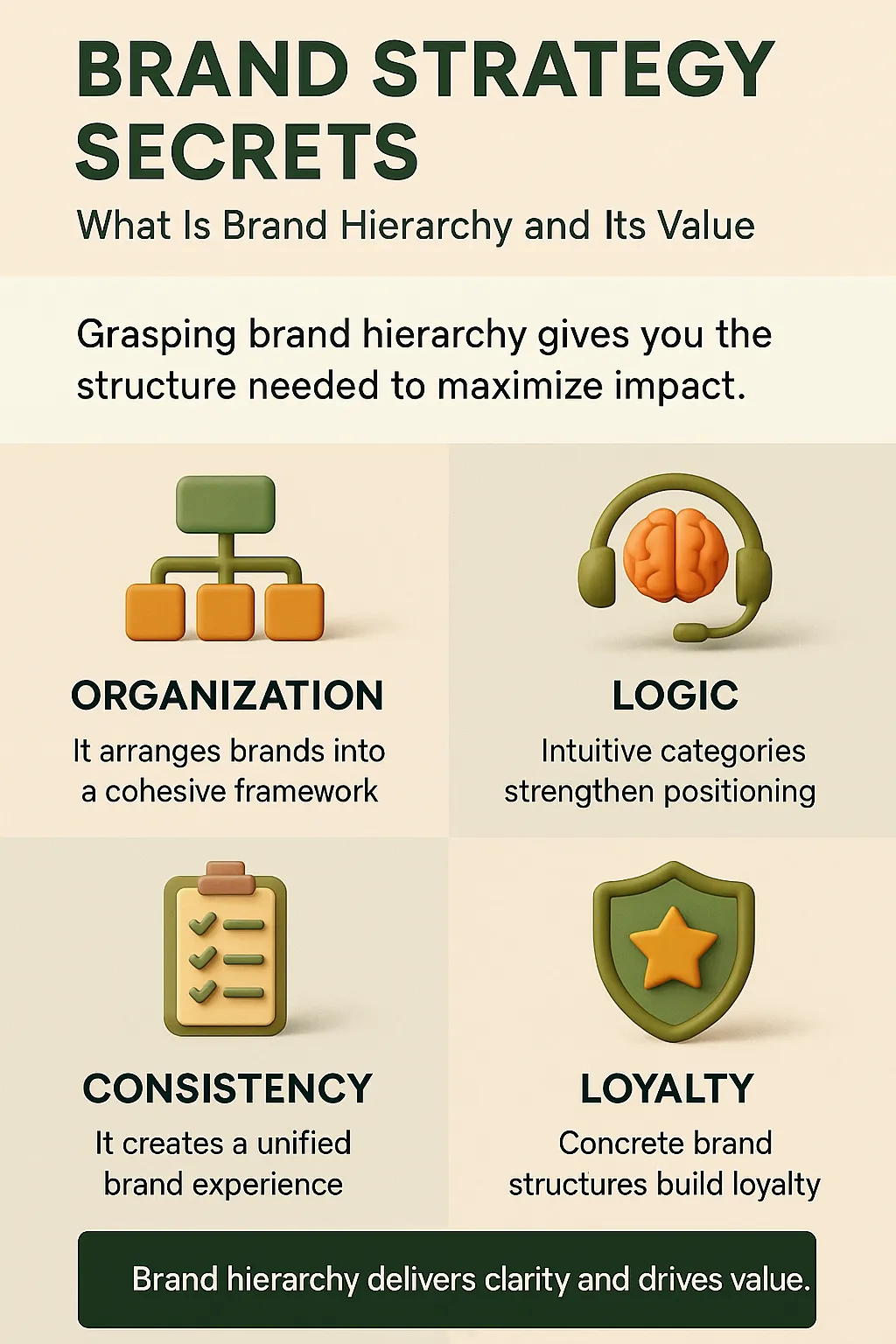Every strong brand tells a story—but what often separates the most trusted brands from the rest isn’t just storytelling. It’s structure. In our work with growing organizations, we’ve discovered a key strategy that often gets overlooked: brand hierarchy.
Brand hierarchy is more than just an internal framework. It’s a foundational branding strategy that shapes how customers perceive and interact with your company. Mastering what is brand hierarchy is key to executing it effectively—because when done right, it not only organizes your offerings, it also reinforces your credibility and strengthens long-term brand equity.
Top Takeaways
- Brand hierarchy creates structure and clarity.
- It boosts recognition, trust, and brand equity.
- Early structure supports smoother scaling.
- Small businesses benefit from simple brand tiers.
- Organized branding improves perception and loyalty.
Why Understanding Brand Hierarchy Unlocks Strategic Value
Brand hierarchy refers to the deliberate organization of a company’s brands, sub-brands, and product lines under a clear structure. It defines how these elements relate to each other and how the market should understand them.
Without hierarchy, brands risk appearing disjointed and inconsistent. With it, businesses can present a cohesive image that builds recognition, enhances marketing impact, and fosters customer trust.
In our experience helping companies scale and streamline, we’ve seen how a well-planned brand hierarchy becomes a strategic asset. It’s not about complexity—it’s about creating clarity that leads to better communication, stronger loyalty, and faster growth. This is especially true for owned SEO marketing agencies, where a clear brand structure supports discoverability, content alignment, and trust across multiple digital touchpoints.
“When your brand elements are structured with intention, every touchpoint becomes an opportunity to build trust—and equity.”
How Brand Hierarchy Solved a Multi-Brand Challenge
We recently worked with a national home services company that had grown rapidly by acquiring regional providers. While their footprint expanded, their brand clarity shrank.
Challenges They Faced:
Inconsistent brand names, designs, and messaging
Low customer recognition of the parent company
Disconnected marketing and higher operational costs
Inconsistent brand names, designs, and messaging
Low customer recognition of the parent company
Disconnected marketing and higher operational costs
Our Approach:
Positioned the parent company as the master brand across all service areas
Introduced endorsed branding, keeping local brand equity while unifying the identity
Simplified service naming, making offerings easier to understand and promote
Positioned the parent company as the master brand across all service areas
Introduced endorsed branding, keeping local brand equity while unifying the identity
Simplified service naming, making offerings easier to understand and promote
The Outcome:
Master brand recognition increased by 43%
Marketing expenses dropped by 21%
Post-service customer trust scores significantly improved
The transformation wasn’t just visual—it was strategic. It turned brand chaos into a cohesive story that built equity across every level.
Master brand recognition increased by 43%
Marketing expenses dropped by 21%
Post-service customer trust scores significantly improved
Proof That Structure Drives Results
Industry research confirms what we’ve seen in practice:
81% of U.S. consumers say brand trust is a prerequisite to purchase
Source: Edelman Trust Barometer
Consistent branding can boost revenue by up to 20%
Source: Lucidpress Branding Report
Marketing leadership roles are expected to grow 8% by 2033
Source: U.S. Bureau of Labor Statistics
These insights reinforce the tangible value of brand structure: it builds the kind of consistency, trust, and recognition that translate into long-term business success—outcomes that top marketing consultants earn by guiding clients toward strategic clarity.
81% of U.S. consumers say brand trust is a prerequisite to purchase
Source: Edelman Trust Barometer
Consistent branding can boost revenue by up to 20%
Source: Lucidpress Branding Report
Marketing leadership roles are expected to grow 8% by 2033
Source: U.S. Bureau of Labor Statistics
What We've Learned
Brand hierarchy adds value by aligning internal operations and customer-facing messaging
It reduces confusion and wasted marketing efforts
Early investment in structure pays off during times of growth, change, or brand expansion
Every brand—big or small—can benefit from a hierarchy that supports its long-term vision
Brand hierarchy adds value by aligning internal operations and customer-facing messaging
It reduces confusion and wasted marketing efforts
Early investment in structure pays off during times of growth, change, or brand expansion
Every brand—big or small—can benefit from a hierarchy that supports its long-term vision
How to Apply Brand Hierarchy to Your Strategy
If you're ready to structure your brand more strategically, follow these steps:
Audit your existing brand ecosystem
Define your brand levels (master, sub-brand, endorsed, product-level)
Align messaging and design across all tiers
Document your hierarchy and make it part of your brand guidelines
Revisit and refine your structure as your business grows
Tip: Involve both marketing and executive leadership to ensure alignment from the inside out—a principle especially crucial when working with a multicultural marketing agency, where internal cohesion directly impacts cross-cultural brand resonance.
Audit your existing brand ecosystem
Define your brand levels (master, sub-brand, endorsed, product-level)
Align messaging and design across all tiers
Document your hierarchy and make it part of your brand guidelines
Revisit and refine your structure as your business grows
Frequently Asked Questions
What is brand hierarchy in simple terms?
It’s the way a company organizes its brands and products to show how they relate to each other—and to the customer.
Why is brand hierarchy valuable?
It provides structure, which creates clarity and trust—essential drivers of brand equity and growth.
How many levels are in a brand hierarchy?
Typically four:
Master brand
Endorsed brand
Sub-brand
Individual product brand
Master brand
Endorsed brand
Sub-brand
Individual product brand







